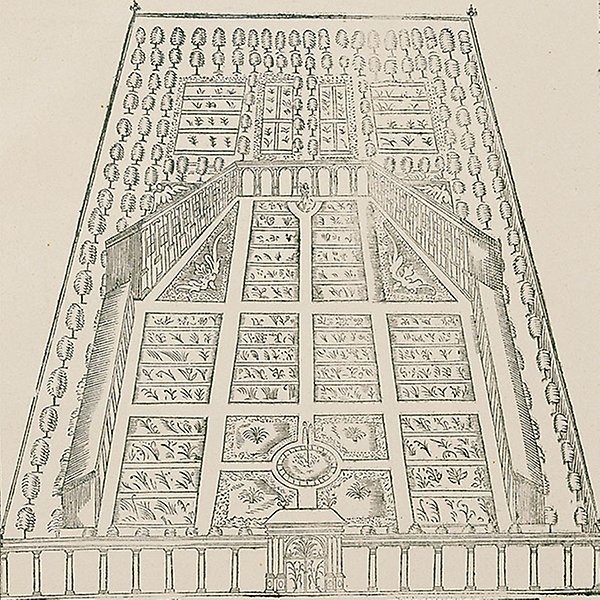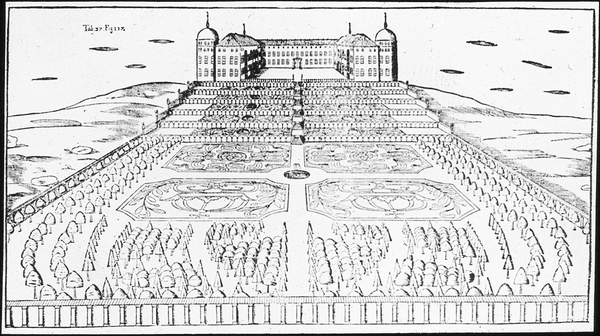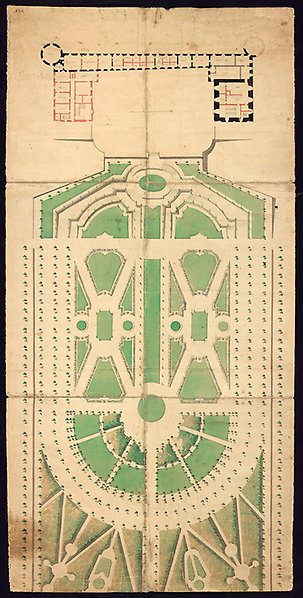History of the gardens
Sweden's oldest botanic garden
The Botanical Garden of Uppsala University is the oldest in Sweden. It was founded in 1655 by the polymath Olof Rudbeck the elder, Professor of Medicine. At that time the garden was located in central Uppsala, in the Svartbäcken district near the Fyrisån river (figure). In the garden the medical students could learn botany and study medicinal plants. By the end of the 17th century there were more than 1800 plant species in the garden, many grown for the first time in Sweden – for example the potato.
Olof Rudbeck’s botanic garden was badly damaged during the great Uppsala fire of 1702. As the university lacked resources to restore it, the garden entered a period of decline.
In 1741 Carl Linnaeus was appointed as Director of the, by then, dilapidated botanic garden. He transformed it into one of the foremost gardens in the world. Through his world-wide network of contacts he was able to bring in thousands of plant species. They were grown in a particular order determined by Linnaeus, according to his Sexual System or in ecological plantings. Today, Linnaeus’ botanic garden has been reconstructed according to his original plan from 1745. It is now called the Linnaeus Garden and is a living memorial to the great naturalist.

Hortus Upsaliensis according to the design of Olof Rudbeck the elder, as published in Atlantica 1675.
The Castle Garden becomes the new botanical garden
The Botanical Garden was previously situated east of the Fyris river, where the Linnaeus Garden is today. The gardens' location close to the river led to many floods. By the late 1700s, the gardens had also become overcrowded. Carl Peter Thunberg, an apostle of Linnaeus and successor, was able to convince Gustaf III of Sweden to donate the gardens of Uppsala Castle to the university in 1787, to be used as Botanical Garden.

Olof Rudbeck den äldres ritning till Uppsala slott och slottsträdgård, det som är Botaniska trädgården idag. Bild lånad från Kungl. Konsthögskolan

Förslag till utformning av Uppsala slottsträdgård 1744 och planritning över Uppsala slott, Carl Hårleman.
By 1807, all of the plants had been moved to the new gardens opened on 21 May, 100 years after Linnaeus' birth. The castle gardens were designed in the Baroque style by architect Carl Hårleman in the 1750s. The king also donated money for the construction of the Linneanum, the building which houses the Botanical Garden's Orangery.
Both the Baroque Garden and the Linneanum are listed property. According to Gustav III's deed of donation, the Baroque Garden must be kept in the same condition as when it was donated. An extensive restoration in accordance with Hårleman's original plans was carried out in 1974.
During the 19th and 20th centuries, the Botanical Gardens have been extended a number of times and new, more functional greenhouses have been added. The gardens' primary purpose is still to serve the research and academic communities. Over time, it has become ever more open to the public and taken on more purposes, such as the conservation of biodiversity. The gardens also function today as a living plant museum with more than 100,000 visitors each year.
The garden by the River Fyris after Linnaeus
After the relocation of the Botanical Garden the old garden by the River Fyris were neglected and transformed into park land and potatoe-patches. The Orangery was reconstructed and used as club house for students at the University and the Director Musices moved into the directors lodge.
The old garden was in a state of neglect for more than 100 years, until 1917, when the Swedish Linnaeus Society was founded and began to reconstruct the Linnaeus´ garden. The restoration was possible thanks to Linnaeus´ detailed plant lists and garden maps. The old residence has been turned into a museum and is still managed by the Swedish Linnaeus Society. The responsibility for the garden has been handed over to Uppsala University.
Carl Linnaeus' Summer Residence – Hammarby
In 1758 Linnaeus bought two small estates: Sävja and Hammarby. During their first summers at Hammarby the Linnaeus family lived in the detached west wing. The main building at Hammarby was built in 1762. Linnaeus also had a small, and reasonably fireproof, museum built at Hammarby where he kept his extensive natural history collections.
Linnaeus received many visitors at Hammarby. Inside or outside the museum, he lectured from a peculiar lecture stool, "plugghästen" (Sw. plugga - to study, häst - horse).
After Linnaeus´ death in 1778 his wife Sara Lisa remained at Hammarby for many years together with two of their daughters. The Swedish State bought the houses and the park from his descendants in 1879 and it is now managed by Uppsala University.
Some famous people from the history of the Linnaean Gardens
The Linnaean Gardens have had several prominent and famous directors: Olof Rudbeck the Elder, Carl Linnaeus and Carl Peter Thunberg. We have also benefited from the expertise of many outstanding head gardeners.
